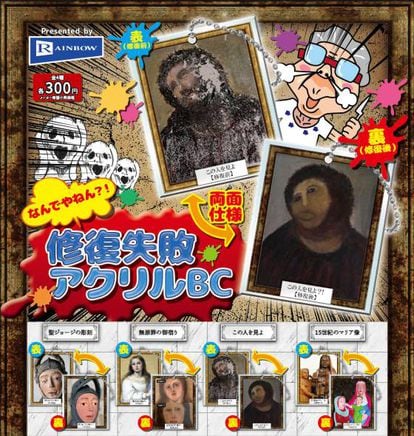 |
| The restoration of the ‘Ecce Homo’ from a church in Borja, in Aragón, is one of the works that has been turned into a keyring. |
A Japanese company is selling Spain’s botched art restorations as keychains
The notorious ‘Ecce Homo’ painting from Borja and the cartoonish work on a 16th-century sculpture are two of four works that are being dispensed in Gashapon vending machines
Spain’s botched art restorations have found a niche in Japan thanks to a series of keychains dubbed “Failed restorations” or Shufuku Shuppai in Japanese. These items are distributed in plastic capsules called Gashapon that can be found in vending machines in train stations, airports and recreational centers.
One of the works that has been turned into a keychain is the infamous restoration of the Ecce Homo painting inside the Sanctuary of Mercy in Borja, in Spain’s Aragón region, which was disfigured beyond recognition by a local amateur artist in 2012. The painting of Jesus went viral on social media, turning into a social phenomenon, with international journalists traveling to the small village to see the work, and artists in the United States creating an entire opera in its honor.
The advertising for the keychains, which are made by the company Rainbow, features a caricature of a woman holding a spatula in tribute to Cecilia Giménez, the elderly woman from Borja behind the Ecce Homo restoration. The caricature is also a nod to an amateur artist from Rañadoiro in Asturias, who in 2018 painted wooden figures dating back to the 15th and 16th century in lurid pinks, purples and greens. This botched restoration is also included in the Japanese keychain series.
In total, Rainbow has made keychains out of four failed restoration attempts – the Ecce Homo and the 15th-century wooden figures, as well as the failed attempt to fix a copy of the famous painting The Immaculate Conception of Los Venerables by Bartolomé Esteban Murillo, and the cartoonish work on a 16th-century sculpture of Saint George in Navarre. Hideyuki Toyoda, the president of Rainbow, says that his company usually makes around 10,000 copies of each keychain image, but in the case of the Spanish works only 1,000 copies have been made of each.

Rainbow had never before worked with Spanish cultural references, nor does the company have business in Spain. Toyoda explains the idea was to do something different. “We wanted to make an unusual product,” he tells this newspaper. “That someone without any experience could deform an artwork from the past is unthinkable in Japan. The public reaction has been so good – the 4,000 units have sold out and the company has even received requests from abroad – that we have been encouraged to do a second series.” The new series, which will be available from January, will include more recent failed restorations, like the sloppy workmanship on a statue in Palencia.
The irreverent humor of these unfortunate restorations makes them perfect for Gashapon collectibles, which also include images of miniature manga characters, art parodies, as well as real and imagined animals. A Japanese manufacturer came up with the idea for the plastic capsules in the 1960s, in response to the first US vending machines, which were considered unhygienic because they dispensed toys and candy simultaneously without any packaging.
Although the toys were initially targeted at children, Gashapons have become popular with all ages and are now found in train stations and airports. The business is estimated to make €270 million a year and around 150 new figures are created every month.
English version by Melissa Kitson.


No comments:
Post a Comment